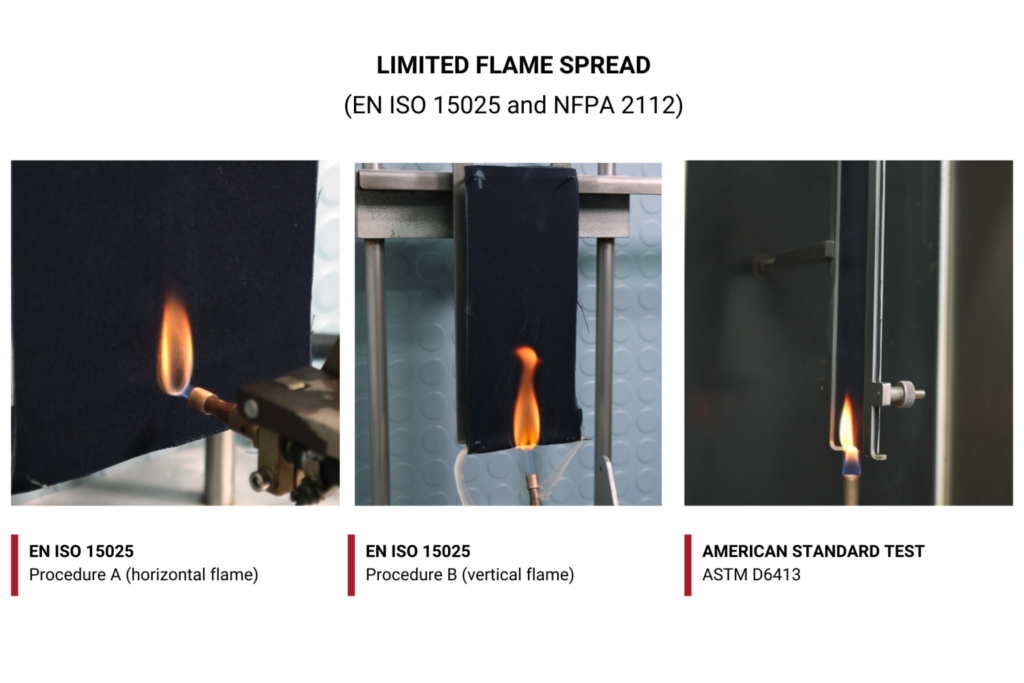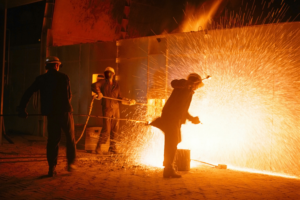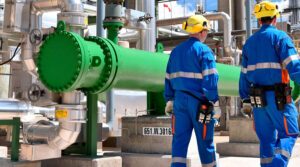limited flame spread
One of the tests we perform to carry out internal quality control of our fabrics is the limited flame propagation test. Depending on the features required by the tested fabric, different verification procedures are carried out. In this post we will explain what each of them consists of.
The EN ISO 11612 is the European standard that specifies the minimum requirements of the fabric to protect against heat and flame.
This standard also verifies radiant heat, contact heat, convective heat, heat resistance, and limited flame spread, among others.
In this article, we will focus on the tests to check the “limited flame spread”, which is defined by the EN ISO 15025 standard. This standard consists of 2 parts, procedure A (horizontal flame, classification A1) and procedure B (flame vertical, classification A2). The A2 is optional.
What is the A1 test?
The test is based on applying a horizontal gas (propane) flame (surface ignition) for 10 seconds (where all measurements, distances, materials and gas flow are given by the standard) to check the behavior of the fabric.
AND A2 TEST?
The test consists of applying a vertical gas (propane) flame at 30º (ignition at the edge) for 10 seconds (where all measurements, distances, materials and gas flow are given by the standard) to check the behavior of the fabric. Unlike the A1, a fold is made on one edge, to simulate the bottom of a garment.
To know if the tests have been carried out successfully, both in the case of A1 and A2, they must meet the following mandatory requirements:
- No test piece should ignite to the top or side edges.
- No test piece must form a hole ≥ 5 mm in any direction (only applies to A1).
- No test tube should give off inflamed or molten remains.
- Post-ignition must be ≤ 2 s.
- Afterglow must be ≤ 2 s.
If the fabric passes the test complying with the previous points, we have the first “green light” to say that the fabric is flame retardant.
hOW IS IT DONE FOLLOWING American standard NFPA 2112?
NFPA 2112 is the American standard responsible for flame resistance of fabrics for personal protection against fire. The testing methods included in this standard are: flame resistance, manikin testing, thermal shrinkage resistance, and heat resistance.
In this article, we will focus on the test to verify the “limited flame spread”, which is defined by the ASTM D6413 Standard Test Method for Flame Resistance of Textiles (Vertical Test).
The limited flame spread test of the American standard consists of applying a vertical gas (methane) flame for 12 seconds (where all the measurements, distances, materials and gas flow are given by the standard) to check the behavior of the fabric.
After exposure to the flame and allowing the fabric to cool, a weight is hung to assess the tear force required to break the charred area. The weight is defined by the standard based on the grammage of the fabric being tested.
To know if the test has been carried out successfully, you must meet the following mandatory requirements:
- No test piece should ignite or drip.
- Post-ignition must be ≤ 2 s.
- The torn char length should be ≤ 100 mm.FOLL







